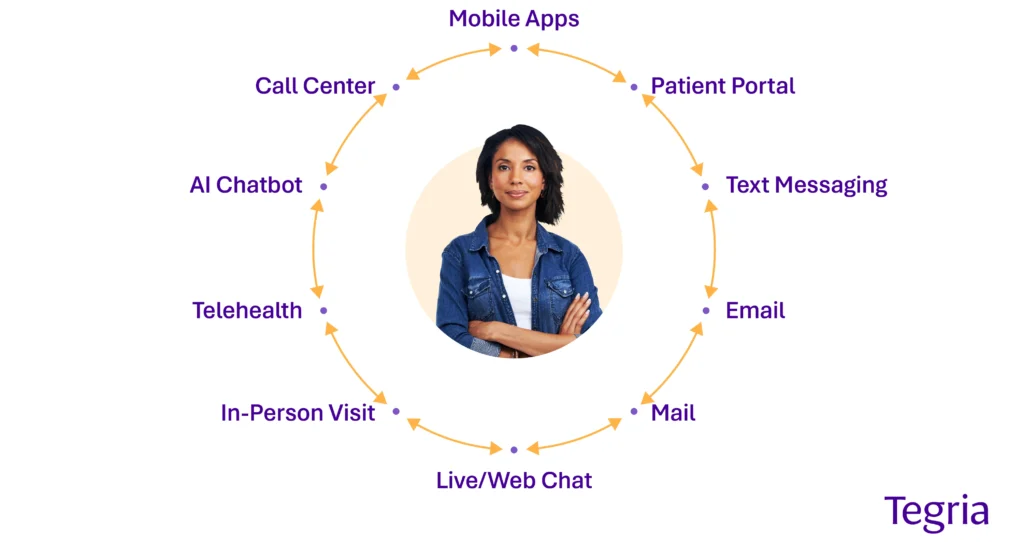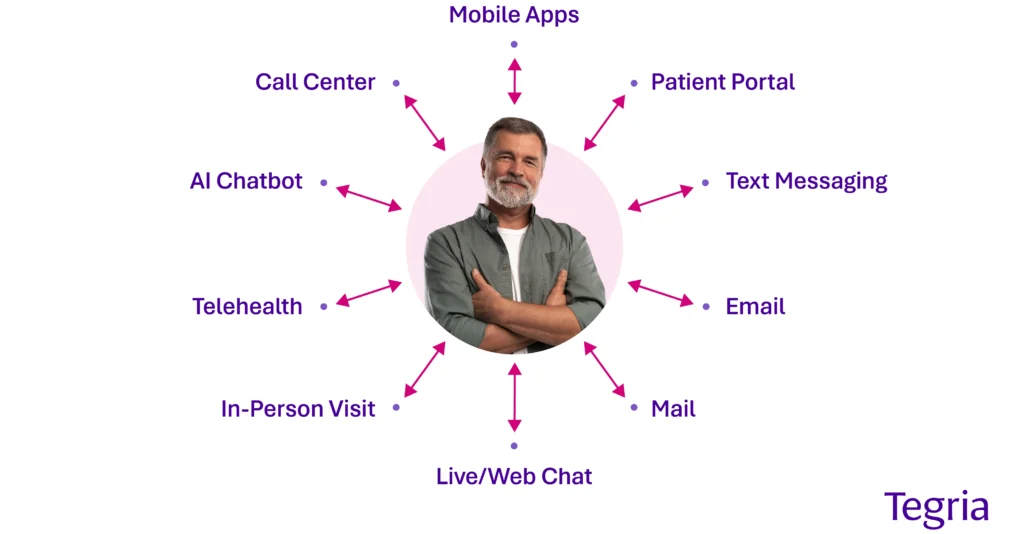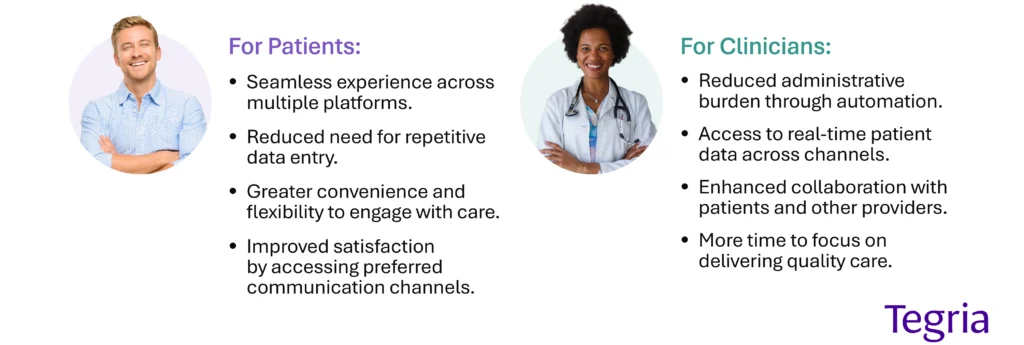Insight
Your Guide to an Omnichannel Patient Engagement Strategy
Healthcare’s digital transformation has provided patients and providers with a wide array of tools to manage care, from mobile apps to patient portals. However, many of these tools operate in silos, resulting in a disjointed and often frustrating experience for patients as they navigate through disconnected systems. Per a KLAS report, only one-third of patients use a patient portal monthly, with many patients reporting that fragmented experiences, limited interoperability between systems, and a lack of personalized options keep them away.
To fix these problems, over three-quarters of health systems have increased their investment in patient engagement, according to a recent survey of CHIME members. Adopting an omnichannel patient engagement strategy will help providers create an integrated patient experience that improves efficiency, increases satisfaction, and drives value.
Omnichannel patient access in healthcare refers to a seamless, integrated approach that allows patients to interact with healthcare services through multiple channels—such as phone, web, mobile apps, and in-person visits—while maintaining a consistent experience across all platforms. This article aims to provide healthcare IT executives and leaders with strategies to improve patient engagement and drive value through an omnichannel approach to access.
Omnichannel Patient Access Model
Interconnected access channels allow patients to transition seamlessly between touchpoints during their care journey.

The Evolution of Patient Access
The healthcare industry has significantly evolved since the inception of patient-centric care nearly four decades ago. We’ve witnessed a steady shift from traditional, fee-for-service care models to more value-based care centered around the patient and their outcomes. This mindset has expanded in recent years with advances in digital health tools that empower patients with greater access to and control over their care.
Traditional Patient Access Models
Many still remember when patient access to healthcare was fundamentally different, relying heavily on physical presence, paper records, and manual processes. Patients typically scheduled appointments by calling or visiting their provider’s office in person. Others, particularly in rural areas, simply walked into clinics where appointments weren’t required. A patient’s access to care, and even their own information, was centered around the provider’s hours and processes. This pre-digital era created a siloed effect that often delayed care and claims processing because it was challenging to efficiently transfer patient records between providers and specialists. Access to specialists was also usually difficult, requiring long wait times and travel to larger cities or regional hospitals.
Traditional Patient Access Model
Siloed access channels with limited functionality require more effort from patients, leading to frustrating experiences as patients navigate between touchpoints.

The Shift to Digital and Multichannel Engagement
Today’s patients seek efficient and secure access to their health information and the ability to schedule appointments, communicate with providers, and view and pay financial responsibilities online. Multichannel strategies have shaped healthcare’s growing digital era by introducing online patient portals, mobile apps, wearable devices, and other digital tools. Despite inherent benefits, multichannel digital tools are disconnected and operate independently of one another. This can lead to a fragmented experience where patients may need to reenter data, search for lab results, or even start over at each new touchpoint in their care journey.
Emergence of Omnichannel Strategies
Omnichannel patient engagement, sometimes called healthcare 3.0, takes the digital era to the next level with a customer-led approach that puts the patient at the center of their healthcare experience. Unlike multichannel access, an omnichannel access strategy integrates all touchpoints to provide a seamless and unified patient experience. Patients can navigate between the different channels without needing to repeat information. At the same time, providers can push pertinent reminders and information to the patient without using multiple texting solutions.
For example, a patient can book an appointment through a mobile app, receive a text message reminder, and then check in via the online portal. After the appointment, the patient may receive care instructions and reminders or choose to communicate with the provider via online chat or a virtual visit. At each patient touchpoint, all channels are synchronized with up-to-date health records and preferences to ensure an optimal experience that promotes engagement.
An omnichannel strategy benefits providers too, by reducing repetitive data entry, expanding access to real-time data, and promoting collaboration with patients and other providers. This frees up valuable time and helps providers feel supported to practice at the top of their license.
Benefits of an Omnichannel Approach to Patient Access

How an Omnichannel Strategy Helps Advance Patient Access
Healthcare organizations today face a dynamic patient access landscape that demands new, innovative approaches. Evolving care models, the need to scale access operations, and the imperative to streamline financial clearance processes are just a few of the hurdles that providers must navigate. Additionally, achieving a solid return on investment (ROI) from digital health strategies requires optimizing patient engagement and operational efficiency.
An omnichannel access strategy helps healthcare providers improve critical aspects of patient access in the following ways:
Evolving Care Models
As care models shift toward value-based care and virtual health, omnichannel access integrates multiple digital platforms—such as telehealth, mobile apps, and patient portals—allowing patients to engage with care across various settings. This flexibility enhances continuity of care and patient adherence, making it easier for patients to navigate through increasingly complex care models.
Scaling Access Operations
Inpatient volumes in hospital settings are estimated to increase by 2 percent over the next 10 years. An omnichannel patient access strategy is inherently future-focused and scalable, helping organizations transition their access operating model as healthcare evolves. By providing multiple channels, including phone, text, apps, and online scheduling, and leveraging automation tools such as chatbots and artificial intelligence, healthcare organizations can handle a higher volume of patient interactions without straining human resources.
Improving Patient Experiences
An omnichannel approach to patient engagement allows HCOs to address common access-related complaints, from confusing scheduling experiences to long appointment wait times. By connecting each touchpoint in a patient’s journey and eliminating the barriers that create frustrating experiences, omnichannel access strategies create seamless, satisfying patient experiences.
Streamlining Financial Clearance
Financial clearance plays a crucial role in patient access by ensuring patients understand costs before receiving care. Omnichannel systems can streamline administrative tasks, such as verifying insurance, calculating out-of-pocket costs, and obtaining prior authorizations across digital platforms. By automating these tasks, providers reduce delays in financial clearance, improving the patient experience and reducing the likelihood of denied claims.
Achieving Digital Health ROI
By implementing an integrated omnichannel approach, providers can drive efficiencies that reduce costs, such as minimizing in-person visits through telehealth and automating routine administrative tasks. This enhances the patient experience and contributes to better financial outcomes and a stronger return on investment (ROI) for digital health initiatives. By reducing the need for redundant engagement tools, healthcare organizations can streamline their digital footprint and maximize the value of their digital health investments.
Modernizing the Patient Call Center for Omnichannel Access
Call centers are an essential, often first, touchpoint in a patient’s care journey. If well-organized, these call centers can handle large volumes of patient requests, enabling patients to book appointments, schedule referrals, and ask general questions.
In addition to traditional call handling, modern contact centers leverage AI and automation to streamline processes like appointment scheduling, prescription refills, and answering frequently asked questions. When complex or sensitive issues arise, call centers can seamlessly transition from digital interactions like chatbots to human agents, ensuring that patients receive the appropriate care and attention. Organizations can opt for a virtual call center to balance workload and workforce across multiple locations—this can be particularly helpful for organizations employing remote workers.
The call center or contact center plays a crucial role in an omnichannel patient engagement strategy by serving as a traditional point of contact and a key integrator for digital interactions. In an omnichannel system, the contact center moves beyond handling phone calls alone and integrates with other communication channels, such as web chats, emails, mobile apps, and even social media. This ensures that, no matter how a patient reaches out, they receive consistent and personalized service across all platforms.
Challenges Facing Healthcare Organizations
Patient access in healthcare has become more complex as organizations grapple with evolving expectations and technological demands. Providers must now address challenges such as fragmented patient data, balancing patient and provider experiences, budget constraints, and navigating the complexities of mergers and acquisitions. An omnichannel access strategy offers a path to streamline operations, enhance the patient experience, and improve financial outcomes by leveraging integrated digital tools, data centralization, and automation.
An omnichannel access strategy helps healthcare providers address the following challenges:
Problem
Fragmented Patient Data
Balancing Patient and Provider Experiences
Budget Constraints and ROI
Mergers and Acquisitions
Solution
Omnichannel patient access unifies patient data across platforms, ensuring a seamless flow of information between EHRs, portals, and communication tools, enhancing care continuity and improving billing and claims accuracy.
By reducing redundancies, streamlining workflow, and employing automation and AI, an omnichannel strategy reduces the administrative burden on providers while enhancing patient satisfaction through personalized, real-time engagement.
An omnichannel strategy unifies an organization’s digital access footprint to eliminate redundant, unneeded tools, optimize existing tools, and automate routine processes to maximize efficiency, reduce costs, and improve patient retention and revenue.
Omnichannel platforms help standardize patient engagement across newly combined systems, creating a unified experience during organizational transitions. Adopting an omnichannel approach to access during M&A can ensure that patient experiences remain consistent.
Best Practices for Implementing Omnichannel Patient Engagement
Identify Operations Challenges and Gaps
Patient journey mapping is a powerful method for identifying key touchpoints and pain points when implementing an omnichannel patient engagement strategy. Understanding how patients interact with healthcare services throughout their care journey, from researching care options to scheduling appointments, checking in, and beyond, is essential. Mapping these various channels and identifying frustrations is integral to achieving an access operating model that improves access to care for more satisfied and engaged patients.
Establish Ongoing Governance
Organizations should consider long-term governance early in the implementation process. Shifting to an omnichannel patient access model is a significant cultural change requiring ongoing employee engagement and leadership buy-in across the organization. Prioritizing governance early in the implementation process and ensuring that governance remains in place as the initiative matures are critical to the long-term success of an omnichannel access strategy.
Ensure Seamless Integration Across Channels
Integration is the core of an omnichannel patient engagement strategy because it ensures that healthcare organizations provide a seamless, consistent, and efficient patient experience. Connecting various systems allows patients to easily access the care they need, from booking appointments to receiving follow-up care, all through a unified platform. Failing to integrate key access touchpoints can cause delays, confusion, and misinformation, which can negatively affect an organization’s brand and patient loyalty.
Leverage Data for Continuous Improvement
Data analytics is a powerful tool for growing patient engagement and ensuring value from digital health investments. Analytics provides insights into patient behaviors and identifies inefficiencies that can shape new strategies for enhanced patient access. By analyzing data generated through various patient interactions, healthcare organizations can better understand patient needs, preferences, and pain points.
Encourage Collaboration Across Departments
A successful omnichannel patient engagement strategy breaks down information silos by integrating everything from scheduling to billing, to clinical care. Success hinges on a unified change management strategy that encourages collaboration among leadership from different departments, including IT, clinical services, operations, and finance. Cross-departmental collaboration helps support organizational goals and fosters informed decisions that align clinical priorities with operational needs. Steps for encouraging this level of collaboration include:
1. Establish a Clear Vision and Shared Goals
2. Create a Cross-Departmental Implementation Team
3. Develop a Unified Communication Plan
4. Clarify Roles and Responsibilities
5. Align on Budget and Resources
6. Facilitate Collaborative Workshops and Training
7. Monitor Progress and Celebrate Success
The healthcare industry’s shift to an omnichannel access model is driven by technology advancements, changing patient expectations, and an ongoing need for more personalized, convenient, and efficient care. People are at the heart of this transformational change, meaning technology alone can’t adequately address their needs. An omnichannel approach to patient engagement creates new efficiencies to meet growing patient demand while alleviating provider burden. It aligns technology with administrative operations, clinical care, and the needs and preferences of diverse patient populations.
As we move forward, developments like AI and ML, chatbots, and virtual assistants are shaping the future of omnichannel patient engagement. These technologies hold enormous potential to transform healthcare as we seek to control costs and drive revenue without compromising care.
Are you ready to take patient engagement strategy to the next level?